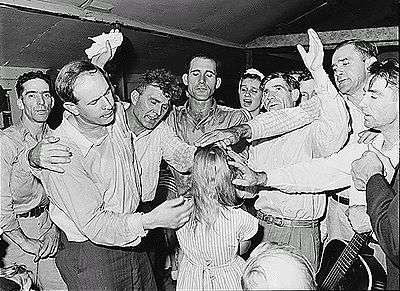Laying on of hands

The laying on of hands is a ritual that is a part of religious practices found in various cultures throughout the world.
In Christian churches, this practice is used as both a symbolic and formal method of invoking the Holy Spirit primarily during baptisms and confirmations, healing services, blessings, and ordination of priests, ministers, elders, deacons, and other church officers, along with a variety of other church sacraments and holy ceremonies.
The practice of laying on of hands is used in Navajo religious ceremonies.[1]
Jewish tradition
The laying on of hands was an action referred to on numerous occasions in the Tanakh to accompany the conferring of a blessing or authority. For example, Isaac blessed his son Jacob by laying on of hands (Genesis 27:27).
Aaron and the High Priests who succeeded him symbolically transferred the sins of the Children of Israel to a sacrificial goat by the laying on of hands: Leviticus16:21. Moses ordained Joshua through semikhah—i.e. by the laying on of hands: Num 27:15–23, Deut 34:9. The Bible adds that Joshua was thereby "filled with the spirit of wisdom". Moses also ordained the 70 elders (Num 11:16–25). The elders later ordained their successors in this way. Their successors in turn ordained others. This chain of hands-on semikhah continued through the time of the Second Temple, to an undetermined time. The exact date that the original semikhah succession ended is not certain. Many medieval authorities believed that this occurred during the reign of Hillel II, circa AD 360.[2] However, it seems to have continued at least until AD 425 when Theodosius II executed Gamaliel VI and suppressed the Patriarchate and Sanhedrin.
Christian traditions
In the New Testament the laying on of hands was associated with the receiving of the Holy Spirit (see Acts 8:14–19). Initially the Apostles laid hands on new believers as well as believers (see Acts 6:5–6). In the early church, the practice continued and is still used in a wide variety of church ceremonies, such as during confirmation.
The New Testament also associates the laying on of hands with the conferral of authority or designation of a person to a position of responsibility. (See Acts 6:6, Acts 13:3; and 1 Timothy 4:14. Also possibly Acts 14:23, where "ordained"—Greek: χειροτονήσαντες—may be translated "extended the hand".) The use of the laying on of hands for the ordination of church officers has continued in many branches of Christianity.
State use
The laying on of hands, known as the royal touch, was performed by kings in England and France, and was believed to cure scrofula (also called "King's Evil" at the time), a name given to a number of skin diseases. The rite of the king's touch began in France with Robert II the Pious, but legend later attributed the practice to Clovis as Merovingian founder of the Holy Roman kingdom, and Edward the Confessor in England. The belief continued to be common throughout the Middle Ages but began to die out with the Enlightenment. Queen Anne was the last British monarch to claim to possess this divine ability, though the Jacobite pretenders also claimed to do so. The French monarchy maintained the practice up until the 19th century. The act was usually performed at large ceremonies, often at Easter or other holy days.
See also
- Anointing
- Exorcism
- Faith healing
- Gifts of healing
- Gift of miracles
- Holy anointing oil
- Hypnosis
- Manual therapy
- Ordination
- Pneumatology
- Priesthood blessing
- Reiki
- Right hand of Christian fellowship
- Snake handling
- Speaking in tongues
- Spiritual gift
- Spirituality
- Superstition
- Thaumaturgy
Notes
- ↑ Lewton, Elizabeth L.; Bydone, Victoria (1 December 2000). "Identity and Healing in Three Navajo Religious Traditions: Sa'ah Naagháí Bik'eh Hózho". Medical Anthropology Quarterly. 14 (4): 476–497. doi:10.1525/maq.2000.14.4.476. ISSN 1548-1387. Retrieved 22 June 2016.
- ↑ Nachmanides, Sefer Hazekhut, Gittin ch 4; Rabbenu Nissim, ibid; Sefer Haterumot, Gate 45; R Levi ibn Haviv, Kuntras Hasemikhah.
References
- New Bible Dictionary (ISBN 0-85110-630-7)
- Parry, Ken; Melling, David, eds. (1999). The Blackwell Dictionary of Eastern Christianity. Malden, MA.: Blackwell Publishing. ISBN 0-631-23203-6.
- Swete, H.B. "Laying on of hands".
- "Imposition of Hands". Catholic Encyclopedia.
- "Ordination". Jewish Encyclopedia.
- Scott, Gini Graham (2002). The Complete Idiot's Guide to Shamanism. Alpha Books. ISBN 0-02-864364-X.